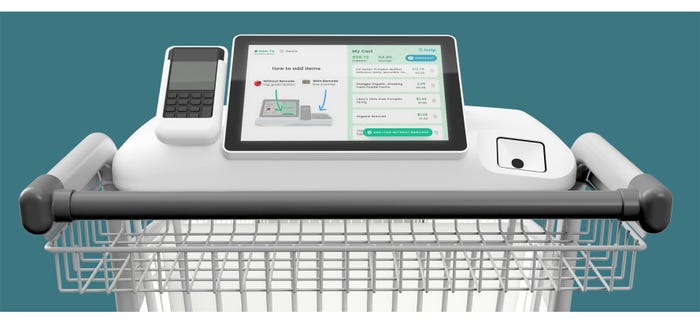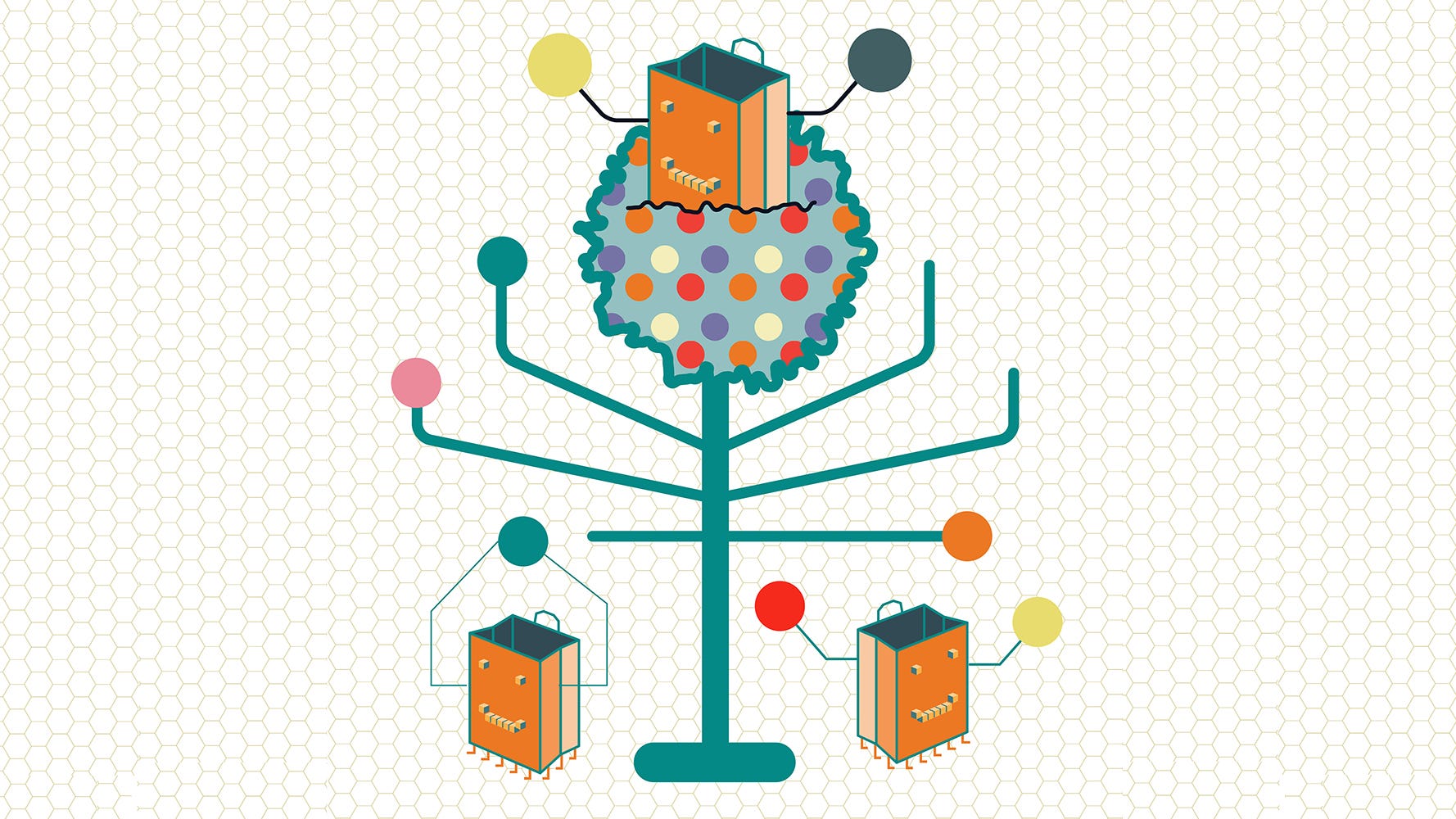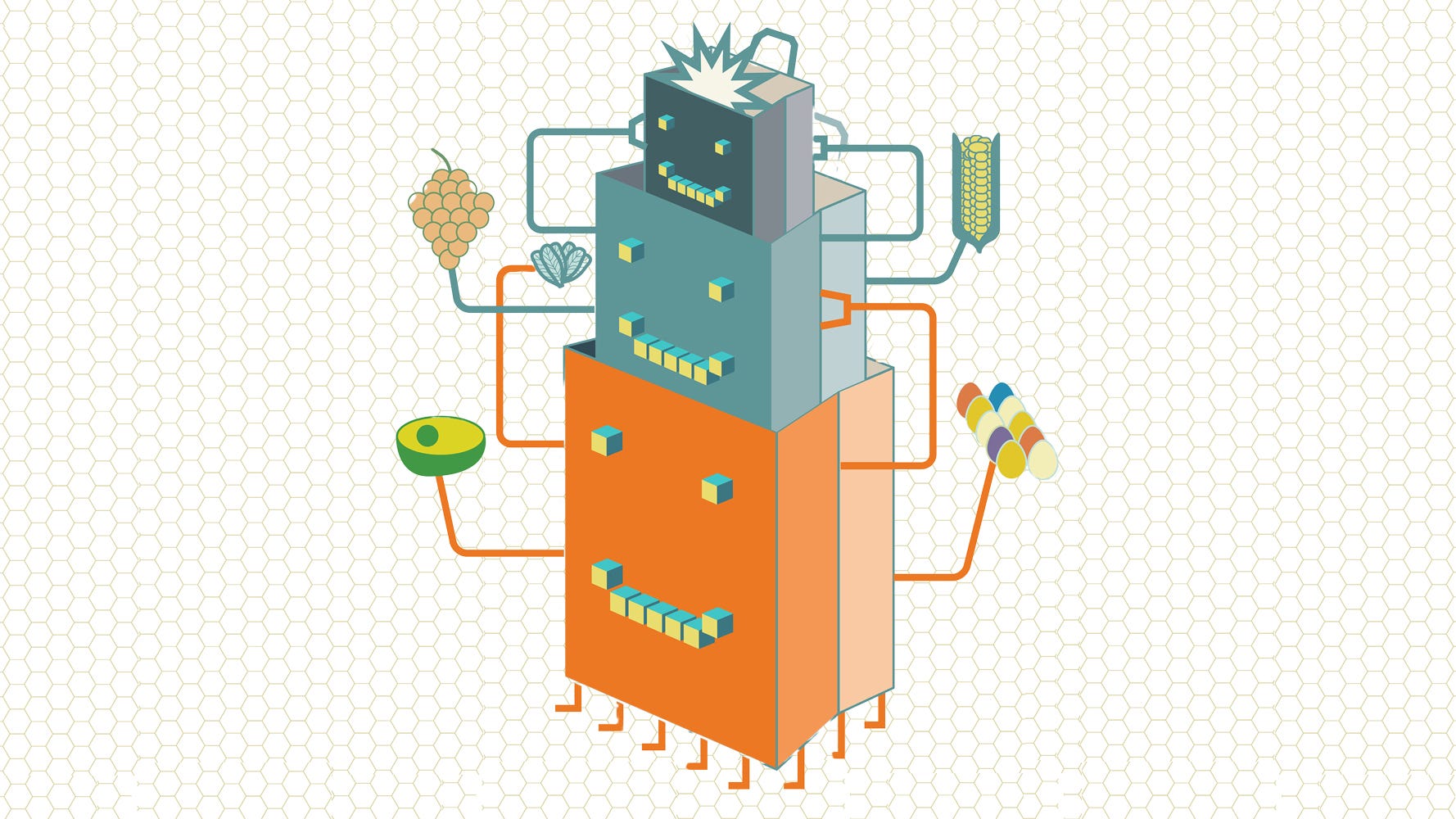
At a Glance
- Artificial intelligence offers retailers suggestions to improve inventory, personalization and customer engagement.
- Customers can enjoy personalized shopping experiences with AI-created custom discounts and AI-equipped smart carts
- Customers can enjoy personalized shopping experiences with AI-created custom discounts and AI-equipped smart carts.
Technology has always played a role in grocery retail—from old-school cash registers filled with pennies and dimes to digital screens inviting shoppers to order sandwiches at in-store delis. The internet, along with the rise of online and mobile shopping, significantly upped the tech ante for grocery stores. Now comes artificial intelligence. Experts predict the changes it brings will be at least as consequential as those spurred by the internet—likely even more so.
Money is pouring into the nexus of technology and grocery, and increasingly, AI will dominate that intersection. For example, in April 2024, five leading global retailers formed W23, a venture capital firm aiming to invest $125 million over five years in startups leveraging technology for tech-enhanced shopping experiences, as well as sustainability challenges and more.
According to the State of Digital Grocery Performance Scorecard, released in 2023, 67% of grocers said they had recently discussed ChatGPT in senior-level meetings. The report also found that 82% of senior executives believe AI will be essential for grocers to compete in the future.
AI applications detailed in the report include inventory forecasting, supply chain operations, pricing and promotions, customer service and tools for employees.
Robots too? Marty the Robot, launched in 2019 and now roaming hundreds of grocery stores, is one of the most prominent examples. Since its debut, Marty has grown quite a bit smarter. The robot now uses AI-driven business intelligence to engage in real-time inventory tracking, as well as identifying and resolving product and price discrepancies. When Marty first hit the aisles, its primary function was alerting customers to potential hazards, such as a shattered jar of tomato sauce in aisle 12.
AI is even playing a role in grocers’ sustainability efforts. In August 2022, grocery technology company Afresh secured $115 million in funding from an investment group that included Walter Robb, a former CEO of Whole Foods Market, now a partner at venture capital firm S2G Ventures. Afresh uses AI to reduce food waste in grocery stores, and the funding will accelerate its expansion.
AI encompasses a diversity of technologies that empower machines to learn, reason and perform tasks traditionally requiring human intelligence. While the release of ChatGPT in 2022 rocketed generative AI into the spotlight, AI is much broader. It also includes predictive analytics, computer vision, robotics, natural language processing and autonomous systems. AI’s impact reaches far beyond chatbots—it’s driving innovation in decision-making, automation and personalized experiences.
The flourishing technology is beginning to offer products for all natural and organic stakeholders. Read on to learn about some of the ways in which grocers are leveraging AI and helping to change the face of grocery shopping.

Smart carts such as the one depicted here can display a running total of items chosen, sync with stores' loyalty programs and help consumers build shopping lists. Credit: Caper Cart
Smart carts: The future of personalized shopping
The ongoing parade of new tech tools can serve as educators for new team members and streamline complicated daily challenges such as managing supply chain. However, many AI tools will directly benefit customers, as well.
Consider smart carts, the new wave of shopping carts tricked out with AI tools to enhance the customer experience. The most prominent player in this space is Instacart, which acquired Caper Carts in 2021.
Retailers of varying sizes, including Bristol Farms, Fairway Market and Kroger, already offer Caper Carts in their stores, according to an Instacart spokesperson who asked to not be named. Geissler’s Supermarket, a seven-store regional and family-owned chain in Connecticut, is in the process of replacing its traditional carts with Caper Carts. By the end of 2024, Instacart anticipates that thousands of its smart carts will be in use across U.S. grocery stores. The spokesperson says the company does not disclose the cost of these carts.
Caper Cart innovations can perform several tasks. They display a running total on a screen as shoppers fill their carts, allow for the use of coupons and sync with retailer loyalty programs. They include gamification features, such as “spin to win” games on cart screens, which offer discounts before checkout. They can also help customers using the Instacart app build shopping lists—Caper Carts align with the app and remove items from the list as they’re added to the cart.
In the future, the carts will also be able to recognize individual preferences and purchase histories, suggesting recipes or products based on past behavior. “The cart might recommend a taco recipe when purchasing tortillas,” the Instacart spokesperson says. “It will be able to offer location-based suggestions too. If a customer is in the cookie aisle and has previously purchased a cookie brand, they might receive information about a new limited-edition flavor from that brand.”
The Caper Carts’ gamification feature has led to customers spending an average of 30 minutes interacting with them, the spokesperson says. Some customers even seek out stores with smart carts, regardless of their familiarity with the store. The company reports that up to 44% of Caper Cart sessions result in at least one digital coupon being clipped and used, driving additional sales.
Promotions powered by prediction
The days of newspaper ads, mailed circulars and store websites trumpeting the same sales to everybody haven’t disappeared—at least not yet. But thanks to AI, they might not last much longer. Developers are creating extremely sophisticated digital tools that tailor ads to individual customers, based on their shopping habits, grocery preferences and more.
“Being able to identify each customer individually among millions is the challenge for grocery retailers today,” says Cedric Chereau, co-founder of Eagle AI, a tech consultancy specializing in digital coupons for grocers. In the past, savvy retailers grouped customers into “segments” for targeted ads. However, AI allows for a more personalized approach, which Chereau describes as a game changer.
The value of AI lies partly in its predictive abilities. Chereau’s company gamifies digital coupon programs for stores, tailoring ads to shoppers based on past purchases and their perceived willingness to stretch their budgets.
For instance, if AI determines that a customer demonstrates loyalty to one brand, it might serve her ads that persuade her to spend a little more to get discounts on those favorite products. The gamification aspect hinges on the technology’s familiarity with the customer: It understands how she shops, what she likes and her willingness to stretch a budget. By spending more, she essentially wins a prize such as discounts on her favorite products.
The targeted ads and gamification feature foster store loyalty, Chereau notes. Some of the largest grocery retailers in Europe, including Tesco and Carrefour, use the technology, and it’s gaining traction in North America as well.
“The technology basically says, ‘Stop popping around every time you’re doing grocery shopping, and you’ll be rewarded very generously,’” Chereau says.

If consumers are willing to share their personal data with retailers, AI can suggest brands or products they might like, target them with advertisements and discounts and even reward their loyalty to the retailer they use.
Targeted to a T: Precision marketing with AI
A major online player in the natural and organic products industry, Thrive Market, is in the process of integrating AI-fueled advertising tools into its online platform, in partnership with Instacart. While technology is at the heart of Thrive Market—the entire business operates online—it wasn’t until the arrival of new AI tools that the company could pursue more personalized experiences for its customers. The company is now implementing tools that serve both customers and brands through AI.
For customers, Thrive Market’s deep reservoir of data—which includes not only shopping behavior but also surveys and other informational activities that customers complete before beginning their shopping journey—will help better tailor searches and advertisements.
“You’re seeing businesses like ours getting more savvy in that space and making it more tailored to the individual, and not just reflecting basket behavior,” says April Lane, Thrive Market’s chief merchandising officer and a former Amazon executive.
For CPG companies, the new platform gives them much more ownership over their campaigns. It also offers AI tools that help them better target potential customers with ads “in a way that is far more accurate and powerful” for both Thrive Market members and brands, Lane says.
However, tapping into all that data comes with some caution, notes Madhavi Chakrabarty, an assistant professor of marketing at Rutgers University.
“If a retailer wants to use AI systems—if it wants to use the power of some of these tools—it now has access to them, which it didn’t have before,” she says. “It makes the whole idea of personalization even more compelling. The challenge is the idea of data ownership. If I want to tailor the experience of my products to what you want, I need to know who you are. For personalization, I need to know a lot about you. And that can violate privacy.”
Gaining access to the data grocery retailers need to create truly personalized relationships with customers will depend on one key factor, Chakrabarty says: Grocers need to create value propositions that persuade customers to share increasingly more about themselves in exchange for improved shopping experiences. And AI can boost the odds of offering strong value propositions.
“The core difference between an AI system and any of these non-AI systems is the idea of intelligence,” Chakrabarty says. “It’s constantly learning from the environment. It’s constantly trying to improve what it’s telling you. If your behavior is changing, AI’s behavior is changing as well, and so are its recommendations.”

Artificial intelligence can help independent and small stores focus on innovation in private label products, popular ingredients and sustainability. AI can assist employees with specific training, as well.
AI for all: Leveling the playing field for small grocers
While consumer-facing technology such as e-commerce has long been part of the grocery business, it has never taken center stage. Stocking the house with everything from ice cream to kale to sunscreen and magnesium supplements is far more personal, routine and complex than, say, shopping for socks.
“Grocers have been laggards from an e-commerce-adoption perspective,” says Barry Clogan, chief product evangelist at Wynshop, a firm that helps grocers leverage technology to improve their bottom lines. “But they now face an unrivaled opportunity. They have incredible data about so much, down to how much salt is in my diet. They have an opportunity to significantly impact the consumer experience and their own internal operations.”
Big grocery conglomerates are clearly embracing an AI-powered future. However, digital assistants and shoppable recipes aren’t limited to the big players.
“If you’re a smaller grocer and can get control over a clear data strategy, there’s an opportunity for AI to level the playing field,” Clogan says. Smaller grocers can take advantage of the same tools the big companies are using. And, due to their smaller scale and relative lack of bureaucracy, they can implement changes more rapidly.
Spencer Price, vice president of strategy at Wynshop, agrees: “Large retailers will have the most advanced capabilities, but they’ll also overreach—whether that’s from a data-privacy or security standpoint or overriding familiar shopping experiences with toys shoppers really don’t love. That leaves smaller grocers with a unique advantage, and that’s the highly personal experience they can provide in the store in a way that makes sense for them and their customers.”
Fast-developing AI tools are also helping grocers of all sizes improve their private-label efforts, Price notes. Wynshop is currently working with a major Midwest grocery chain that is using AI to help understand where it should innovate, which brand messages resonate with customers and which ingredients are most compelling among shoppers at the moment.
While regional chains and mom-and-pop grocers today begin to explore AI, many of the larger players have been wading in the AI waters for a year or more. For example, Walmart is exploring voice-activated, hands-free AI-powered technology. The app can engage in conversations with shoppers, helping them with myriad shopping-related tasks.
Albertsons, too, is leaning heavily into AI. In a September episode of “The Speed of Culture” podcast, Jill Pavlovich, the company’s senior vice president of digital shopping experiences, extolled how AI is rapidly transforming grocery shopping. One recent AI-driven innovation she highlighted is making recipes shoppable.
“Leveraging generative AI and a few other technologies, we’re actually able to ingest customer recipes, whether they upload a picture into their private app, manually upload it or input a URL,” Pavlovich says. “We can ingest that recipe, make sense of it, match it back to our product catalog and make it instantly shoppable for them—essentially creating their own digital recipe book.”
This technology extends beyond shoppers too. In August, Target announced the rollout of a new AI-powered chatbot called Store Companion to hundreds of thousands of Target team members across nearly 2,000 stores nationwide, including many Targets with grocery aisles.
“The transformative nature of generative AI is helping us accelerate the rate of innovation across our operations, and we’re excited about the role these new tools and applications will play in driving growth,” says Brett Craig, Target’s executive vice president and chief information officer, in a news release.
For example, the technology allows employees to enter prompts like “How do I restart the cash register in the event of a power outage?” or “How do I sign up a guest for a Target Circle card?” and receive immediate answers. The tool also serves as a training coach, among other functions.
Why not try AI?
Today’s nascent AI landscape offers powerful tools and solutions for all organic and natural grocers, regardless of size. Just as with things such as websites and store apps, however, stores will approach new technologies with wildly divergent levels of enthusiasm—from downright rejection to close hugs. And few stores would credit their triumphs—or blame their failures—on the degree to which they synced up with technology.
Many grocery retailers today don’t support store apps. Most have websites, but not all of them take advantage of digital real estate. In plenty of cases, the websites offer little more than basic information—and there’s no shortage of retailers doing well without devoting resources to their digital footprint.
Either way, checking out ways in which AI could help with everything from streamlining supply chain to boosting advertising efficiency and results can’t hurt. As technology matures and ripens, and offers increasingly more tools designed explicitly for retailers, many will end up taking advantage of at least a few AI-powered technologies to help bolster their bottom lines. There’s nothing stopping grocers from getting started today.
Editor’s note: When this story was originally published in the Winter 2024 edition of Natural Foods Merchandiser, Brett Craig’s name was wrong. It has been corrected here.
About the Author
You May Also Like
.png?width=700&auto=webp&quality=80&disable=upscale)





